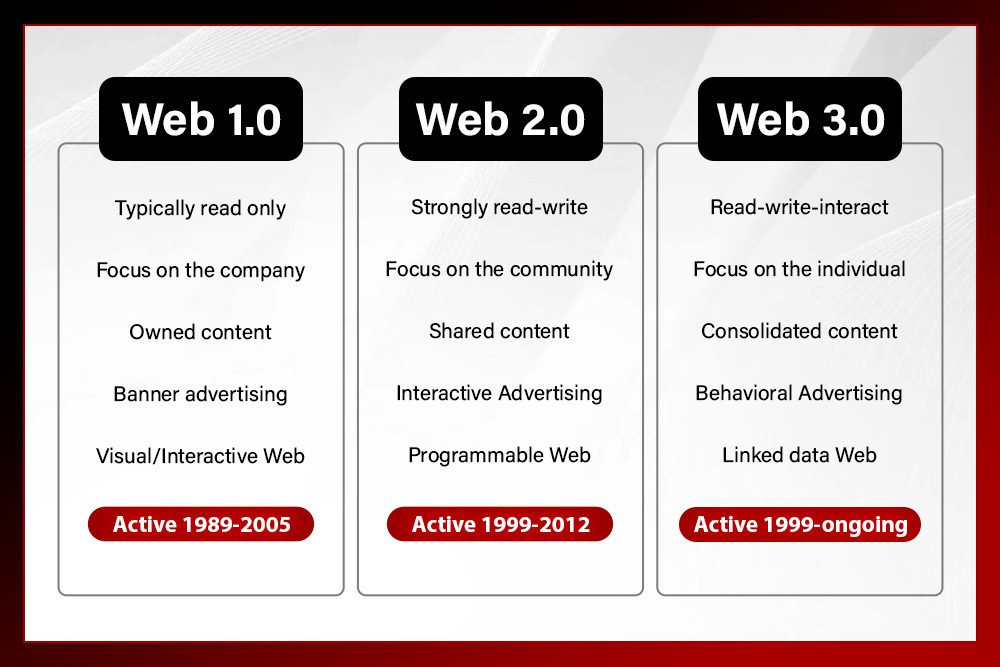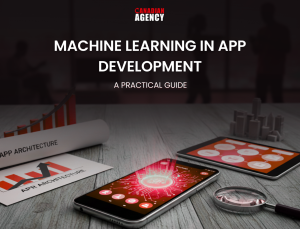The Internet has come a long way since its inception, and its evolution has been marked by distinct phases known as Web 1.0, Web 2.0, and the emerging Web 3.0. Each phase represents significant advancements and changes in how we use and interact with the World Wide Web. In this blog, we’ll delve into the characteristics, features and implications of Web 1.0 vs. Web 2.0 vs. Web 3.0 and shed light on their unique contributions to the digital landscape.
What Is Web 1.0?
Web 1.0, often called the “static web,” laid the foundation for today’s internet. It emerged in the early 1990s and was characterized by basic HTML websites with limited interactivity. During this era, the internet primarily served as an information repository, and users could only consume content passively. Web 1.0 websites were static and lacked the dynamic elements we see today.
These early websites provided valuable information but lacked user engagement and collaboration. Examples of Web 1.0 technologies include AOL and Geocities, which offer simple web pages with static text and images.
What Is Web 2.0?
Web 2.0, a revolutionary shift in the internet’s evolution, emerged in the early 2000s, transforming the static web into a dynamic and interactive platform. With the advent of Web 2.0, the internet became more user-centric, enabling users to participate and contribute content actively.
This era saw the rise of social media platforms, such as Facebook, Twitter, and YouTube, allowing users to create and share content, connect with others, and engage in meaningful interactions. Blogs, wikis, and forums also became popular, facilitating collaborative content creation and knowledge sharing.
Web 2.0 transitioned from a one-way information flow to a two-way, interactive experience. It empowered users to be content creators, leading to the democratization of information.
What Is Web 3.0?
Web 3.0, the current and emerging phase of the internet, is characterized by a focus on intelligent and personalized experiences. Also known as the “semantic web” or “intelligent web,” Web 3.0 aims to create a more interconnected and contextually aware online environment.
At the heart of Web 3.0 lies artificial intelligence (AI) and machine learning, which power intelligent algorithms capable of understanding user preferences and delivering tailored content. This phase enables consistent data integration from various sources, creating a more cohesive and personalized user experience.
Web 3.0 envisions a future where virtual assistants, smart devices, and IoT technologies work harmoniously, anticipating users’ needs and providing contextually relevant information. This advanced level of personalization can potentially revolutionize industries like healthcare, e-commerce, and education.
Uses of Web 1.0 vs. Web 2.0 vs. Web 3.0
Web 1.0, despite its static nature, played a crucial role in disseminating information. It served as an online library, offering vast amounts of data and research materials. Businesses used Web 1.0 to showcase their products and services through basic websites.
Web 2.0, with its focus on user-generated content and social interactions, opened the door to new possibilities. Social media platforms became hubs for connecting with friends, sharing experiences, and promoting businesses. Blogging and content sharing allowed individuals and organizations to establish their online presence and build communities.
Web 3.0’s intelligent and personalized nature promises to elevate the internet experience further. It has the potential to revolutionize e-commerce by providing tailored product recommendations, enhancing healthcare through personalized treatment plans, and redefining education through adaptive learning platforms.
What Are the Differences Between Web 1.0 vs. Web 2.0 vs. Web 3.0?
The evolution of the World Wide Web has seen three distinctive phases. Web 1.0 marked the early days with static, read-only websites, offering limited user interaction and content creation.
Web 2.0 brought a paradigm shift, introducing dynamic and participatory experiences where users could interact, create content, and engage with others on platforms like social media and collaborative websites.
With Web 3.0, we witness a new era of personalization and interconnectivity driven by intelligent algorithms and AI. This advanced phase caters to individual preferences, providing tailored content and services through AI insights while also fostering a seamless connection between various applications and devices, offering a unified digital experience.
Let’s break down and examine the differences between the Webs using this handy table:
| Web 1.0 | Web 2.0 | Web 3.0 |
| Typically read-only | Strongly read-write | Read-write-interact |
| Owned content | Shared content | Consolidated content |
| Visual/Interactive Web | Programmable Web | Linked data Web |
| Home pages | Wikis and blogs | Waves and live streams |
| Web page | Web service endpoint | Data Space |
| HTML/HTTP/URL/Portals | XML/RSS | RDF/RDFS/OWL |
| Page views | Cost per click | User Engagement |
| File/web servers, search engines, e-mail, P2P file sharing, content and enterprise portals | Instant messaging, Ajax and JavaScript frameworks, Adobe Flex | Personal intelligent data assistants, ontologies, knowledge bases, semantic search functions |
| Directories | Tagging the user | User behavior |
| Focus on the company | Focus on the community | Focus on the individual |
| Encyclopedia Britannica online | Wikipedia | The Semantic Web |
| Banner advertising | Interactive advertising | Behavioral advertising |
| Active 1989-2005 | Active 1999-2012 | Active 2006-ongoing |
We can also say that Web 1.0 helped people find things online better, Web 2.0 enabled people to experience things better, and Web 3.0 helped people create things online better.

What Are the Similarities Between Web 1.0, Web 2.0, and Web 3.0?
Web 1.0, Web 2.0, and Web 3.0, despite being distinct stages in the evolution of the internet, share common traits that form the backbone of the digital world. All three phases are accessed through web browsers using HTTP and URLs, while HTML remains a fundamental language for content presentation.
The internet’s global reach allows users worldwide to access diverse content comprising text, images, audio, and video. While each phase offers varying levels of user interaction, they all facilitate engagement with online resources. Furthermore, the evolutionary progression from one stage to the next demonstrates the continuous development and innovation in web technologies.
Notably, the impact of these phases extends beyond technology, transforming commerce, communication, and social interactions on a global scale. As technology and user demands continue to evolve, the internet will perpetually advance, introducing new possibilities and shaping the digital landscape further.
What Are Web 1.0, Web 2.0, and Web 3.0 Features?
The World Wide Web has evolved through three distinct phases, each with its defining features. Web 1.0, or the static web, comprises static websites offering limited user interaction and read-only content. It provided the initial foundation for the Internet but lacked personalization and dynamic elements.
Web 2.0, the dynamic web, revolutionized the online experience by introducing interactive websites, user-generated content, and social media platforms. Users could actively participate, collaborate, and share their creations, shaping a more engaging digital landscape.
Now, in the era of Web 3.0, the intelligent web takes center stage, leveraging AI, machine learning, and the semantic web. Web 3.0 aims to deliver personalized experiences, context-aware services, and seamless cross-platform integration, offering users a highly tailored and interconnected online ecosystem.
Potential and Pitfalls of Web 3.0
Web 3.0, with its emphasis on personalization, intelligent algorithms, and interconnectivity, holds tremendous potential to transform the digital landscape. However, it also comes with certain pitfalls and challenges. Here’s an overview of the potential and pitfalls of Web 3.0:
The potential of Web 3.0:
Personalized Experiences: Web 3.0 has the potential to offer highly personalized experiences to users, tailoring content, products, and services based on individual preferences and behavior. This level of personalization can enhance user satisfaction and engagement.
Intelligent Automation: By incorporating AI and machine learning, Web 3.0 can automate complex tasks. This improves efficiency and productivity in various domains, such as customer support, content curation, and data analysis.
Context-Awareness: Web 3.0 applications can be context-aware, providing relevant information based on user location, environment, and historical data. This contextual understanding can lead to more relevant and timely assistance.
Seamless Integration: Web 3.0’s interconnectivity enables seamless integration of data and services across multiple platforms and devices. This can create a unified user experience, making it easier for users to access and manage information.
Advancement in the Internet of Things (IoT): Web 3.0 can significantly advance the Internet of Things (IoT). Allowing IoT devices to communicate and interact more intelligently with each other and with users.
Enhanced Data Insights: AI-driven data analysis in Web 3.0 can generate valuable insights, benefiting businesses, researchers, and policymakers to make informed decisions.
Pitfalls of Web 3.0:
Privacy and Security Concerns: As Web 3.0 relies on extensive data collection and analysis; there are heightened privacy and security risks. Ensuring user data protection and mitigating potential breaches become critical challenges.
Algorithmic Bias:
AI algorithms used in Web 3.0 can be prone to biases, leading to unintended discriminatory outcomes in content recommendations and decision-making.
Dependency on AI and Automation:
Excessive reliance on AI and automation may lead to job displacement and potential economic repercussions, especially if certain industries undergo significant disruption.
Information Overload:
The personalized nature of Web 3.0 can result in an overwhelming amount of information for users. Thus making it challenging to filter and prioritize relevant content.
Ethical Concerns:
As AI becomes more sophisticated, there are ethical dilemmas surrounding using AI for decision-making, privacy invasion, and potentially harmful applications.
Standardization and Interoperability:
The seamless integration across various platforms and devices may face challenges. These challenges are related to standardization and interoperability, hindering the full realization of Web 3.0’s potential.
To harness the potential of Web 3.0, it is essential to strike a balance between innovation and responsible implementation. Robust data protection measures, transparent AI algorithms, ethical guidelines, and a collaborative approach to standardization can help create a Web 3.0 ecosystem. These implementations benefits individuals, society, and businesses alike.
Looking Beyond Web 3.0
As technology continues to evolve, speculation about the future of the web never ends. Some predict the rise of Web 4.0, with even more advanced AI and immersive virtual experiences. Others envision a decentralized web where blockchain technology drives increased security and ownership of data.
Conclusion
The evolution of the web from Web 1.0 to Web 3.0 has been a remarkable journey. From static pages to interactive platforms and now to the era of intelligent personalization, the internet’s transformation continues to shape our lives. Embracing these changes while being mindful of the challenges they present will ensure a brighter and more inclusive digital future.




